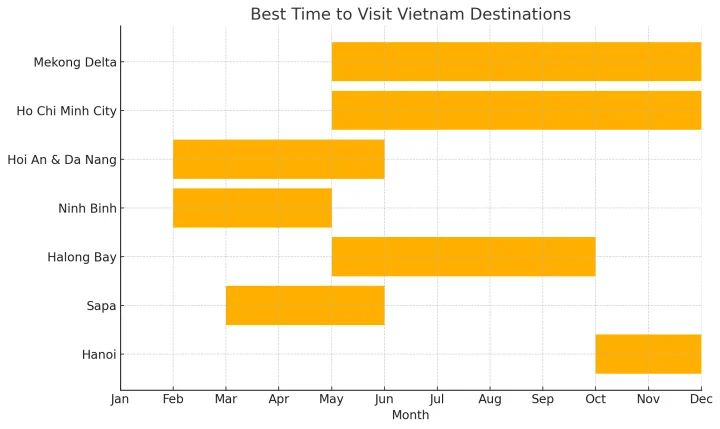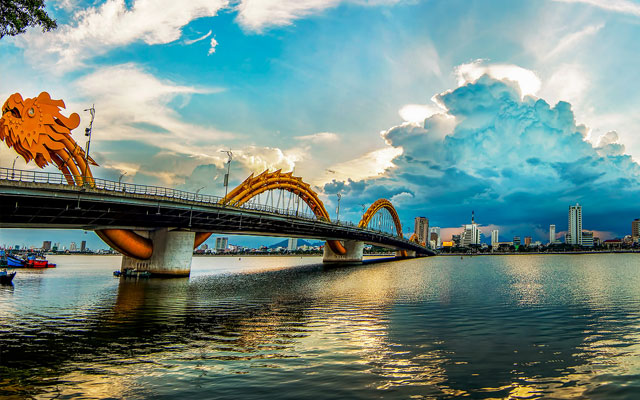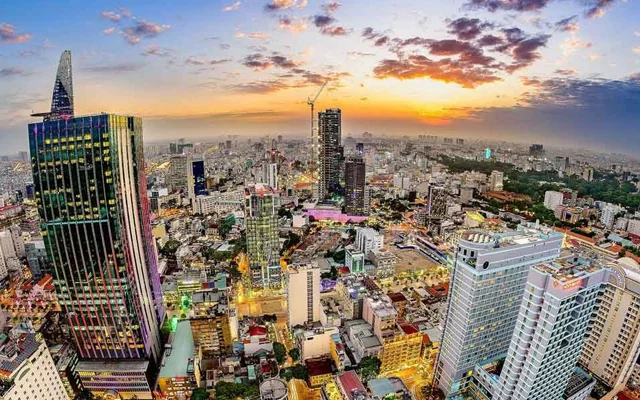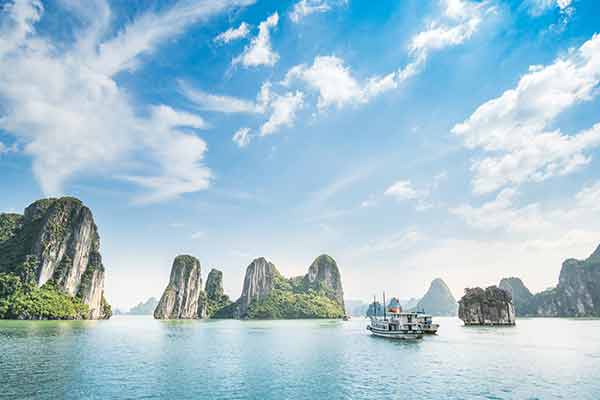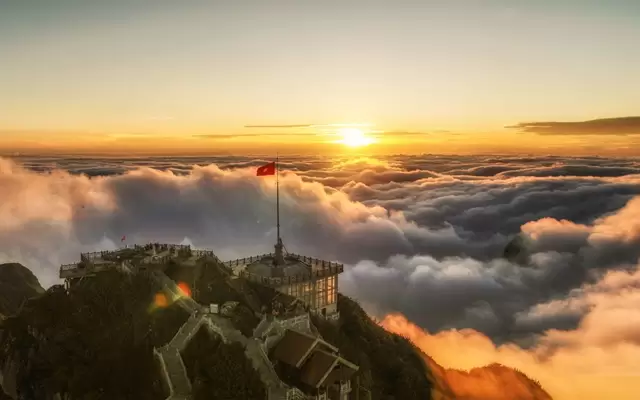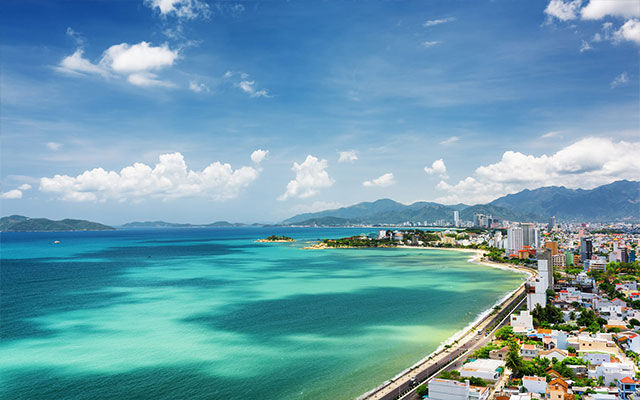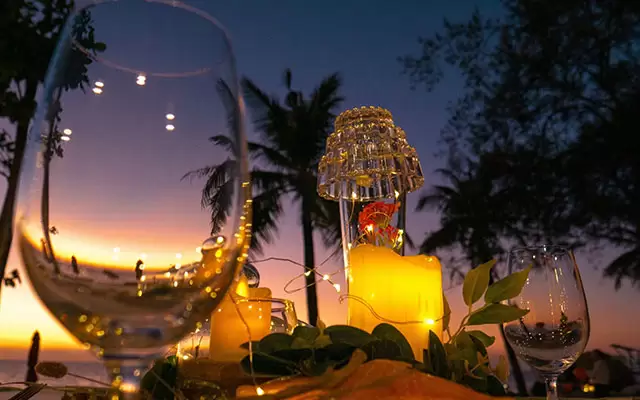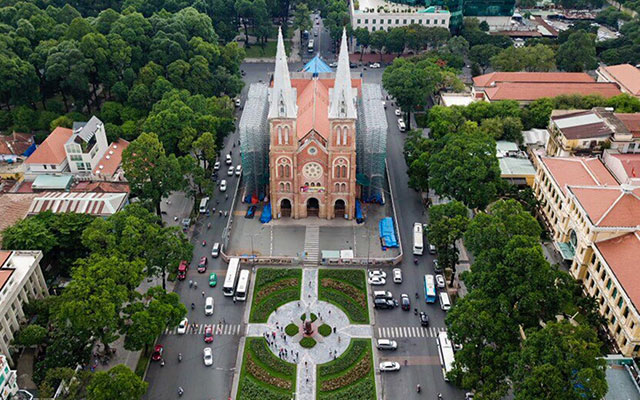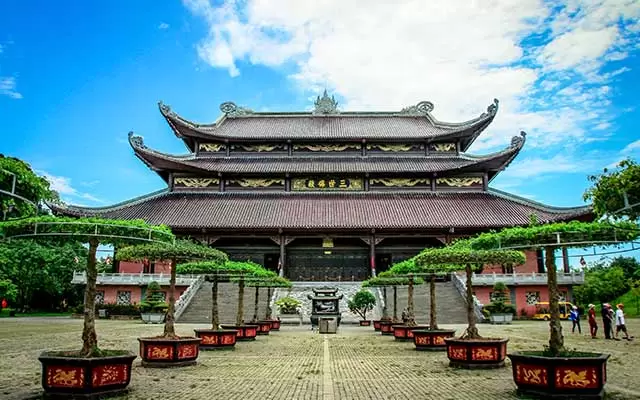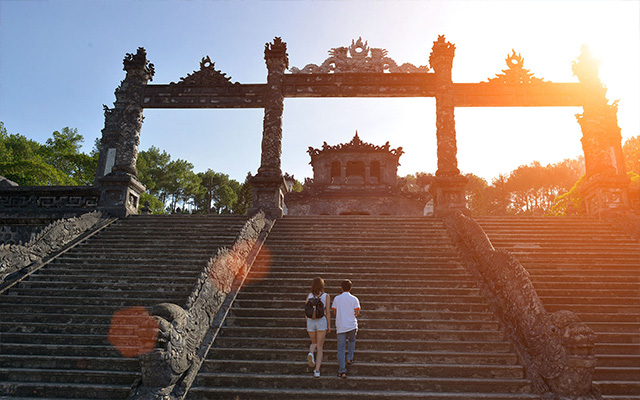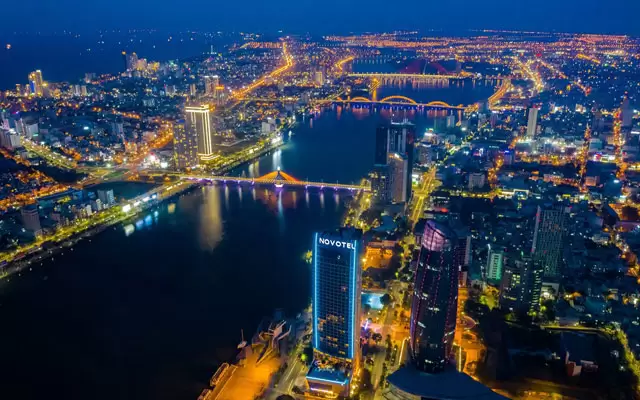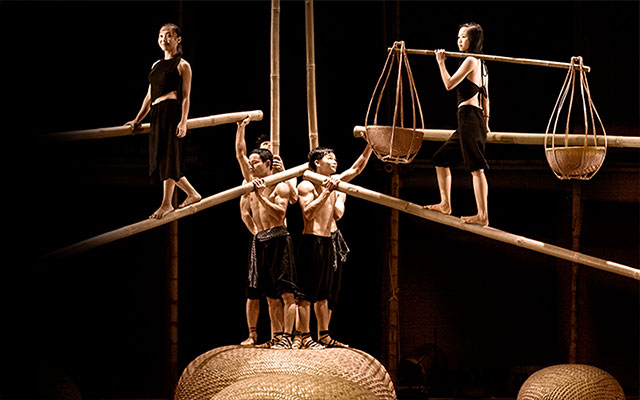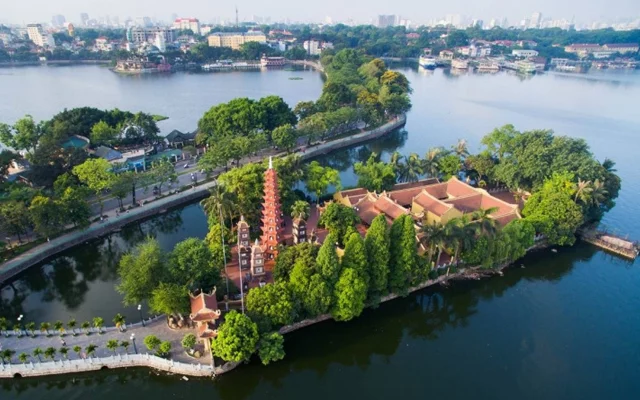When Is The Best Time To Visit Vietnam?
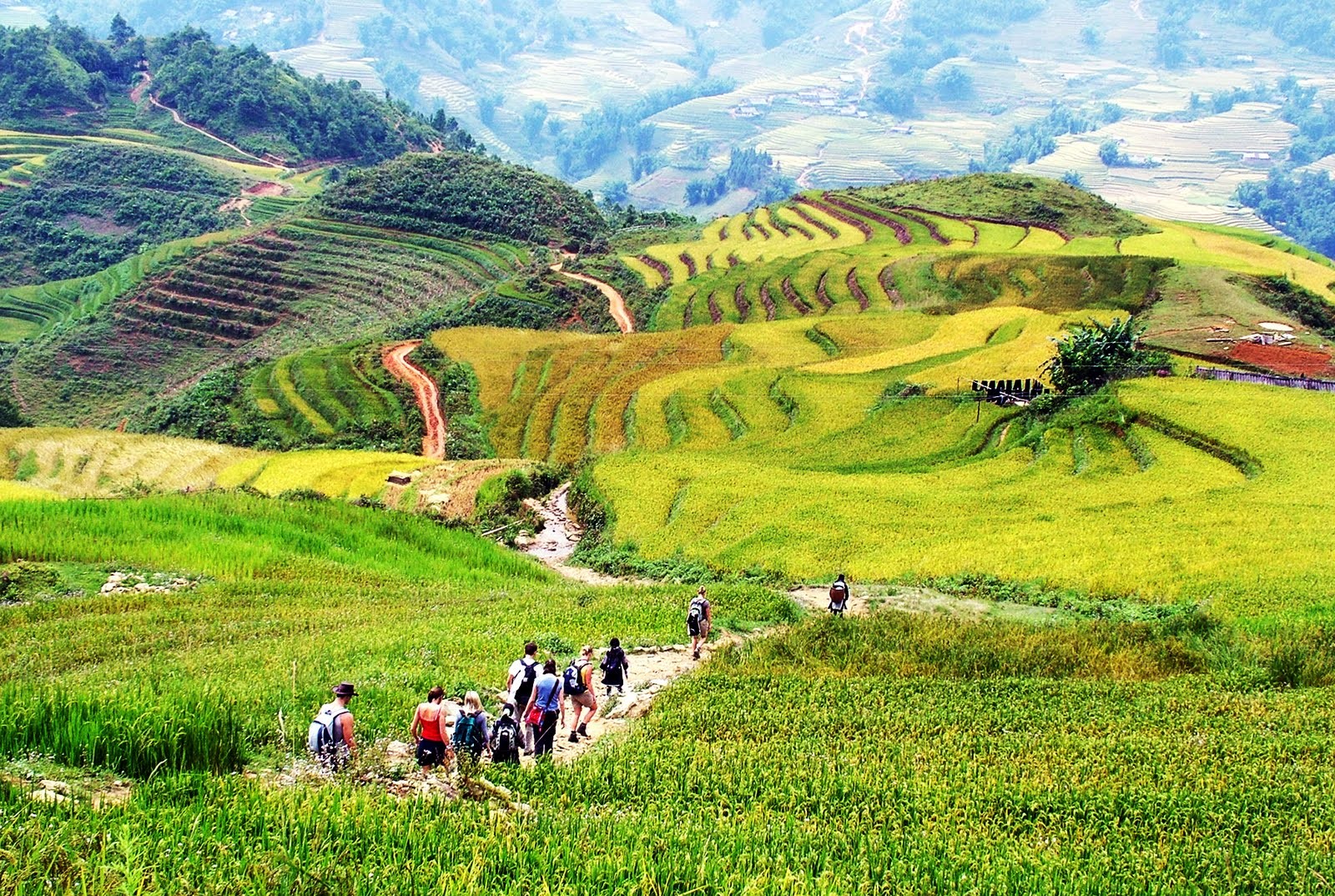
Golden light spills across Sapa’s rice terraces - the perfect snapshot of Vietnam’s peak-season charm
Vietnam is a captivating country in Southeast Asia that offers a rich cultural heritage, stunning natural beauty, and diverse ethnic diversity. However, Vietnam also has a complex and varied climate that can affect your travel plans and experiences. This article will guide you through the climate by month, helping you discover the ideal regions to visit throughout the year for the best possible experience, ensuring you know that any time is a good time to explore some part of this incredible nation. Whether you want to explore the historic capital of Hanoi, witness the spectacular scenery of Halong Bay, or relax on the tropical island of Phu Quoc, we will help you plan your trip to Vietnam based on when to go.
Before planning holidays in Vietnam, you might wonder when is the best time to visit Vietnam. The answer is quite simple and encouraging: anytime is the best time! With recent enhancements like more flexible visa policies (updated in 2023) offering longer stays and expanded visa-free access for many nationalities, and a tourism sector booming with new luxury accommodations and international recognition (like the Michelin Guide’s arrival), planning your Vietnamese adventure has never been more appealing.
Thanks to its long, stretching terrace of over 1,600 kilometers, Vietnam has a diversified climate from North to South, although both regions are influenced by a monsoon climate. The Northern climate generally has four distinct seasons, with the northeast monsoon bringing cooler, drier weather from October to April. The South enjoys a tropical climate with two main seasons: dry (typically November to April) and wet (May to October), where the south or southwesterly monsoon is dominant from May to September. So, figuring out the best time to visit Vietnam truly depends on which parts of the country you wish to explore and your preferences for weather conditions. Even during the wet seasons, rain often comes in predictable, short bursts, leaving much of the day clear for exploration.
If you’re dreaming of a comprehensive tour of Vietnam, understanding its regional climates is essential. While spring (roughly March-April) and certain parts of autumn (September, late November-December) are often cited as favorable periods to experience diverse regions, it’s crucial to note specific variations. For example, October and early November can bring heavy rain and storms to Central Vietnam. However, this exemplifies Vietnam’s strength as a year-round destination: if Central Vietnam is experiencing its wet season, the North often boasts clear skies and pleasant temperatures ideal for trekking, while the South transitions into its beautiful dry season. Strategic planning, therefore, always unlocks fantastic travel options somewhere in the country.
Traveling during what some consider the ‘low season’ (which varies by region but often includes May to October for parts of the country) can be a rewarding experience with fewer crowds and potential value. Weather during this period is diverse: Southern Vietnam typically sees brief, refreshing afternoon downpours, often followed by sunshine. Concurrently, Vietnam’s Central Coast enjoys its sunniest and driest period from May to August, making it perfect for beach holidays. In Northern Vietnam, these months are warmer and more humid with more frequent rain, which nurtures stunningly lush landscapes, though mountain activities might require more flexibility. By understanding these regional patterns, travelers can find excellent conditions and unique experiences across Vietnam year-round.
At Vietnam Travel, we look at detailed weather factors and recommend how these might affect your holiday plans in Vietnam. Now, please have a look at our month-to-month guide to visit Vietnam.
Table of Contents
January
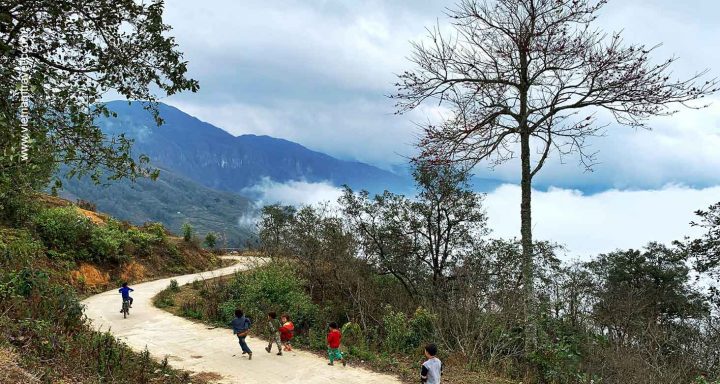
There are a lot of things to do in Vietnam from north to south in January. In the North, January brings cool winter weather. It is often the coldest month in mountainous areas like Sapa, where rainfall is at its lowest, making it perfect for trekking amidst stunning landscapes. You can also visit Ha Giang to witness the beautiful plum flowers blooming; if temperatures dip low enough (around 0°C), you might even see frost, adding a unique charm – though snow is a rare sight. Hanoi at this time experiences cool and generally dry weather, with average daytime temperatures reaching around 20-21°C, while evenings and nights can be cooler, averaging 14-17°C, ideal for city exploration. Additionally, you can enjoy the bustling and festive atmosphere as Lunar New Year (Tet) preparations get underway in the north if the festival falls late in the month or early February.
In January, Southern Vietnam is well into its dry season, making it an excellent time to visit Ho Chi Minh City. Enjoy the beach paradise, pristine islands, and water-related activities like diving and snorkeling in Mui Ne and Phu Quoc.
Central Vietnam, with the rains having largely subsided, also welcomes visitors to explore its beautiful white sand beaches in destinations like Nha Trang, Da Nang, and Quy Nhon.
January is generally a dry month across much of Vietnam, with varying temperatures. The North is coolest, with an average of around 17-18°C in Hanoi, while the South is warmest, averaging about 26°C. Central regions enjoy moderate averages around 23°C. While inland mountains might see some light precipitation early in the month, most of the country is dry, offering excellent travel conditions. For more tips and information read this article on Vietnam in January.
February

Vietnam often experiences excellent weather conditions across many regions in February. The South and the Central Coast are perfect for beach enthusiasts. You should spend time on beautiful beaches, enjoying tasty seafood and street foods in Hanoi Old Quarter, Phu Quoc islands, Da Nang, and Hoi An.
Since February is a season of flowers, visitors can breathe in the fresh air and enjoy the natural landscape of spring blossoms such as plum, apricot, and peach blossoms in Sapa and Moc Chau.
This month often coincides with the Lunar New Year (Tet), the most important holiday in Vietnam. You can experience the wonderfully festive atmosphere everywhere you go. While it’s a fantastic cultural experience, note that many businesses, including restaurants and museums, may have altered hours or close for a few days during this period. Accommodation can also be in high demand as many Vietnamese travel for the holidays, and the transport system is busier. Therefore, don’t forget to contact us in advance to check available accommodation and make arrangements.
February is largely a sunny and dry month in Vietnam, with mild to warm temperatures across the country. Average highs can be around 30°C (86°F) in the south, with lows around 21°C (70°F). The North remains cooler, with an average of about 17°C, while the South is warm and can be humid. Rainfall is minimal in February, though some misty haze might occur along the coast and in Halong Bay, adding to its mystical charm. You can enjoy many outdoor activities like cycling, boating, and exploring the countryside. Visiting a floating market in the Mekong Delta offers a vibrant cultural experience. For more details and tips on Weather in Vietnam in February, check out this article.
March
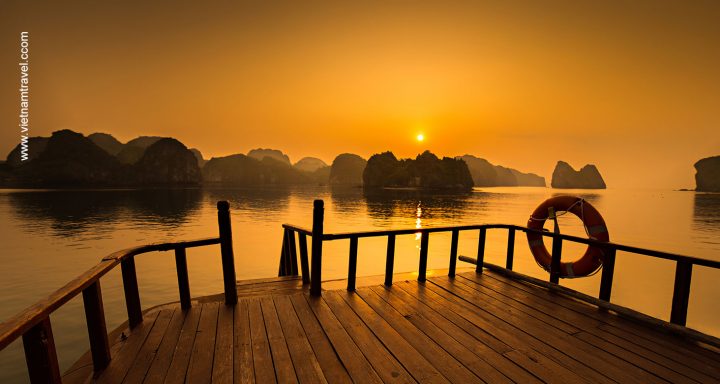
March is often considered an excellent time to explore the whole country. The temperature is generally pleasant, often ranging from 20°C to 25°C in many areas, making it suitable for trekking in highlands and mountains. Halong Bay is typically very stunning at this time. As is Phong Nha – Ke Bang National Park, which boasts some of the world’s biggest caves, with March offering favorable conditions for cave exploration.
Da Lat in the Central Highlands becomes particularly beautiful at this time with cherry blossoms. The weather is cool with sunshine, making it an enchanting destination.
Lying down to sunbathe or taking part in water-related activities is ideal for visitors who want to lazily enjoy their holiday at Nha Trang, Da Nang, and An Bang beach (near Hoi An).
March is a good month to visit Vietnam, as the weather is mostly dry and sunny across much of the country. However, there are some regional variations.
In March, North Vietnam enjoys a spring-like climate with mild temperatures and low rainfall. Central Vietnam is typically warm and dry with pleasant temperatures and low humidity. South Vietnam is generally hot and dry. Average temperatures in Hanoi, Da Nang, and Ho Chi Minh City are approximately 19°C (66°F), 26°C (79°F), and 28°C (82°F) respectively. It’s recommended to pack layers for North Vietnam, light clothes and sunscreen for Central and South Vietnam.
April
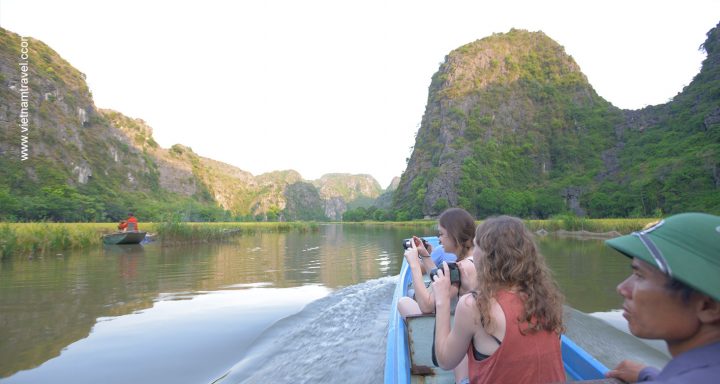
April is often the last month of spring, signaling the end of the main Lunar New Year festive season and the cooler winter period in North Vietnam. From this month onward, the average temperature and humidity throughout the country tend to rise. However, it’s still very pleasant and great for hiking, with spring flowers in full bloom making many regions especially beautiful.
Visitors should consider coming to Ninh Binh to admire its beautiful scenery in Trang An and Tam Coc while boatmen sail you through the long and peaceful rivers amidst lush landscapes.
If you want to know more about Vietnam’s ancient emperors, Hue with its Forbidden Citadel is very promising. Besides, if you want to experience religious culture, the Perfume Pagoda in the outskirts of Hanoi is often at its most beautiful and less crowded in April, as the main festival period concludes.
April is also an excellent month to visit Vietnam’s best beaches and islands like Halong Bay and Da Nang city, with average temperatures often around 27-29 degrees Celsius. The beaches typically have blue water and calm waves.
Vietnam generally has warm and sunny weather in April, but temperatures differ by region. In the North, the average temperature can rise by about 5°C from previous months, staying between 25°C and 30°C. There might be some rainy days, but it’s usually less foggy than March. In the Central region, from Da Nang to Nha Trang, it is a great time to enjoy the summer beaches with an average temperature of 28°C and very little rain. Hue in Central Vietnam and Da Lat and the Central Highlands in the west also typically have good weather.
The weather in Vietnam in April can be varied. Days are often hot and nights mild, so visitors should bring light and comfortable clothes. The highest average temperature can reach 33°C and the lowest average temperature around 25°C in some southern areas.
May

May is a good month before summer fully arrives in Vietnam, so the temperature rises slightly, often towards 30 degrees Celsius. However, you can barely feel intense heat in early May. It might be getting wetter in some areas, but it’s often easy to avoid the short afternoon downpours, which refresh the air. Therefore, it’s still mostly dry in many parts and great for exploring the great outdoors in Ha Long Bay, Pu Luong (famous for its butterfly season in May), and Ninh Binh.
The central coast, including Nha Trang and Da Nang, typically offers pristine beaches and sunny days, perfect for relaxation. Towards the end of May, the renowned Da Nang International Fireworks Festival (DIFF) often kicks off (for 2025, the event runs from May 31 to July 12).
May is a good time to travel to Vietnam with potentially reasonable prices and mostly dry weather in many key destinations. The average temperature is often between 28°C and 30°C. You may encounter some afternoon showers in the north and south towards the end of the month.
The North can be hot and humid, with some rainy days (average temp: 29°C). The mountains are still favorable for exploring Mu Cang Chai and Sapa, though Ha Giang might see more rain. The central coast is generally very comfortable, enjoying its dry season.
If you want to avoid the largest crowds and enjoy warm and sunny weather, May, June, and September can be excellent months to visit many parts of Vietnam. The North is cooler from October to December, while the central coast is at its best from March to August.
June

June marks the beginning of summertime in many parts of Vietnam, potentially bringing a noticeable rise in temperature and humidity. Rain may become more frequent in some areas, but often it only lasts for 30 to 60 minutes, typically in the afternoon. When it ends, the atmosphere is fresher, and skies can be clear and blue, suitable for photo taking.
Do not let the prospect of rain deter you from visiting Vietnam in June. Hanoi and the Mai Chau valley in the north are still pleasant to enjoy, with lush green landscapes. The central coast is typically at its best, so it’s perfect for relaxing on the beaches near Hoi An, Da Nang, Lang Co, Mui Ne, and the Con Dao islands. June also offers the best weather to enjoy the spectacular Da Nang International Fireworks Festival (DIFF), which continues through this month.
June is a hot and humid month in parts of Vietnam, with more frequent rain in the North and South, alongside high temperatures. The average temperature can range from 26°C to 35°C (79°F to 95°F), varying by region.
The North of Vietnam can be quite wet in June, especially in the mountain areas. The average temperature is around 30°C, but it can be cooler in the highlands. The central regions typically have sunny and dry weather, with ideal conditions for beach towns like Hoi An, Nha Trang, and Da Nang. The average temperature here is also around 30°C, with lots of sunshine.
The South of Vietnam has a tropical monsoon climate. While June is part of the wet season, you can expect some heavy but often short showers and thunderstorms, interspersed with sunny days. This period brings incredibly lush landscapes to the Mekong Delta.
July
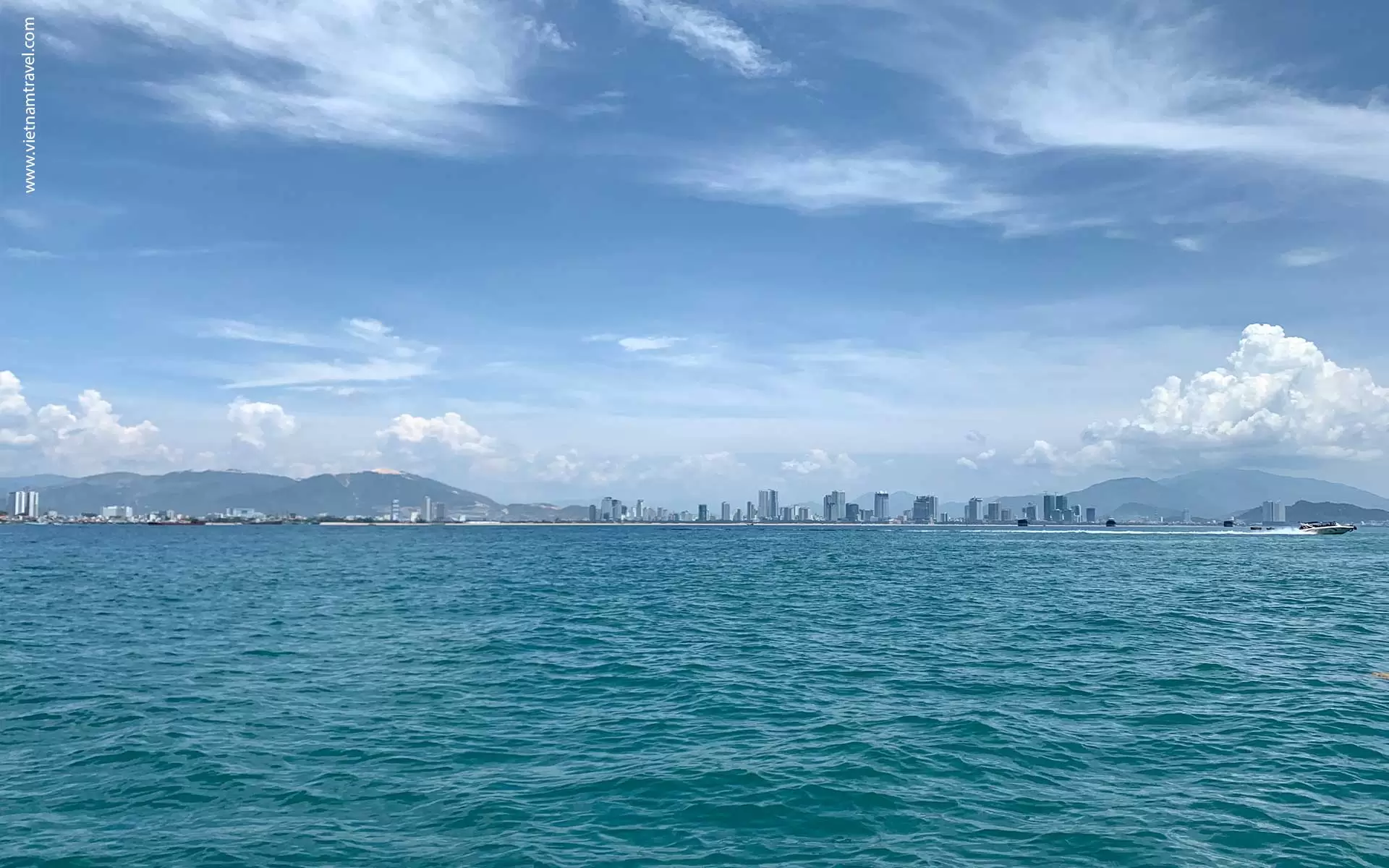 Nha Trang City – View from Spectrum of the Sea.
Nha Trang City – View from Spectrum of the Sea.
July can see temperatures reaching high levels, potentially up to 40°C during heatwaves in some areas, with accompanying rain in the North and South. However, this month is perfect for enjoying beaches across the central coast. You can choose the hottest days for a trip to Nha Trang or Mui Ne. Visitors can enjoy crystal clear ocean, sunny skies, and delicious seafood. July is also a great time to visit the cities of the central coastal line: Da Nang (where the DIFF typically concludes mid-July), Hoi An, and Hue. Or you can choose to find cooler temperatures by visiting Da Lat in the Central Highlands, though it’s part of its wetter season. While the North and South experience their wet season, Halong Bay can still be visited, though occasional weather disruptions are possible but rare. Phu Quoc and Con Dao also remain options, with warm seas and a mix of sunshine and afternoon showers.
July is a peak travel season for Vietnam’s central coast. You should book your hotels early, as prices can go up. The weather is hot and humid across much of the country, though the far north sees more rain. You may also experience some summer monsoon rains, which contribute to the lush green scenery.
North Vietnam has its rainy season in July, with high temperatures and humidity. The average daily temperature in Hanoi is around 29°C (84°F), but it can be lower in mountainous areas like Sapa and Ha Giang.
Central Vietnam enjoys sunny and dry weather in July, with occasional light showers. The beaches and islands of this region are the main attractions in this month. The average temperature is often above 31°C (88°F) during the day. The South continues its wet season, with warm temperatures and regular, usually short, afternoon showers.
August

The temperature in August remains high in many areas but might not be as intense as in June and July in some parts; rains in the North and South can cool down the heat. Hanoi typically sees temperatures between 27 to 32 Celsius degrees and the lush, rain-fed landscapes around the city are vibrant. While it’s the wet season in the North, August can still be a good month to visit the caves in Phong Nha Ke Bang (though always check local conditions as heavy rain can affect accessibility) or relax on the white beaches of Cat Ba island (near Halong Bay), being mindful of potential showers. Central Vietnam, including Nha Trang and Hoi An ancient town, generally continues to enjoy good weather, though rainfall may start to increase towards the end of the month in some central areas. And especially, please do not forget to take part in the unique sand sliding experiences found in Mui Ne, which is also pleasant at this time.
September
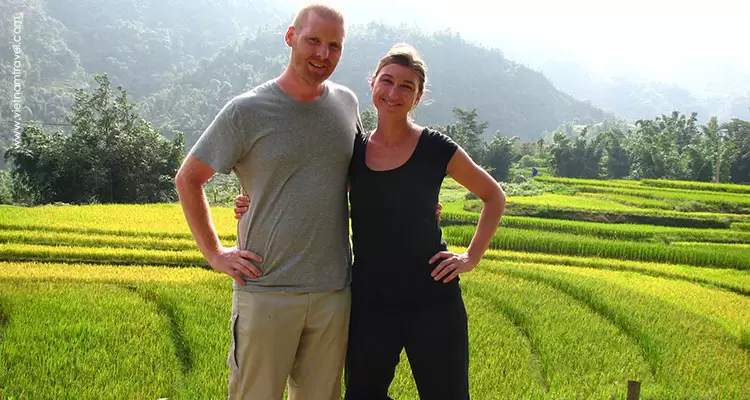
In the North and South, September often marks a transition from summer, with temperatures potentially dropping slightly and conditions becoming drier, particularly towards the end of the month. This opens up the possibility of excellent trekking once more in the north, around Sa Pa. As one of the best months to visit many parts of Vietnam, September offers diverse weather conditions and natural landscape features. Cat Ba island, Halong Bay, Phu Quoc, and Mui Ne generally have great conditions to enjoy the water and scenery. Mountainous areas like Sapa and Mu Cang Chai start their harvesting season: terraced rice fields turning golden, which creates a picturesque landscape that visitors cannot take their eyes off. Central Vietnam begins its transition into the rainy season, especially in coastal areas like Hoi An and Da Nang, though early September can still offer pleasant days.
October
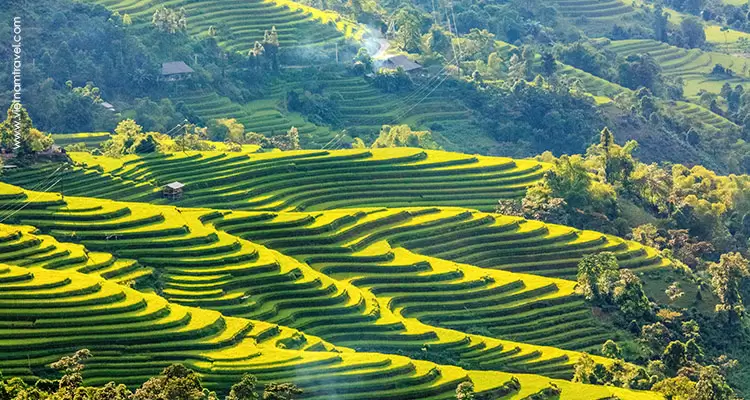
If you plan to visit Vietnam in October, you cannot miss Ha Giang or Mai Chau in the North. Ha Giang appeals to travelers with its beauty of golden terraced rice fields (early October) and the stunning pink fields of buckwheat flowers (typically mid-October onwards). As the summer heat subsides, visiting Hanoi is perfect, and trekking in Sapa is great with clear skies and comfortable temperatures.
In October, Da Lat in the Central Highlands often becomes a romantic town as fog can cover house roofs and trees, in addition to the beauty of colorful blooming flowers; the rainy season here is also tapering off. Meanwhile, in the South, it is getting drier and remains warm, making it a great month to visit Can Tho in the Mekong Delta and its floating markets. Central coastal regions like Hoi An and Hue are usually in their wettest period, so alternative regions offer better conditions.
November
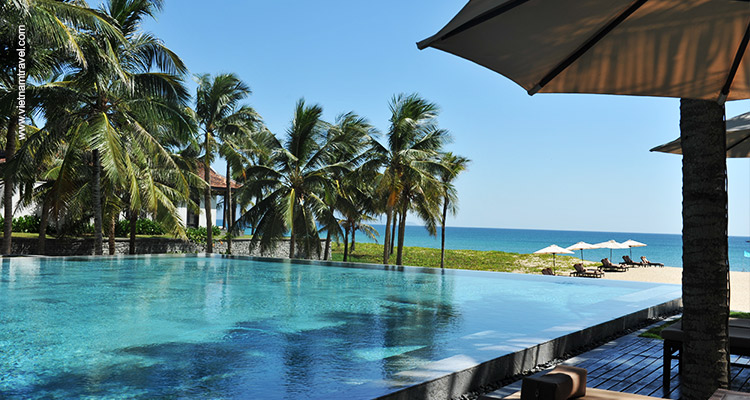
November is an ideal month to have a long trip in Vietnam because the weather in the South is generally balmy and dry, and conditions in the North are favorable with cool, clear days. You can choose either to visit beaches in the South (Mui Ne, Phu Quoc, Con Dao) or go trekking in the North (Sapa, Mai Chau). As well, Halong Bay is a place you should not miss, with typically clear skies.
Hanoi at this time becomes very enchanting with a cooler breeze, the changing leaves of trees, and gentle autumn sunshine. Visitors may feel nostalgic because of its charming scenery. Central Vietnam’s coastal areas are often still experiencing rain, though conditions may start to improve towards the end of the month. Da Lat, however, enjoys pleasant, dry weather.
December
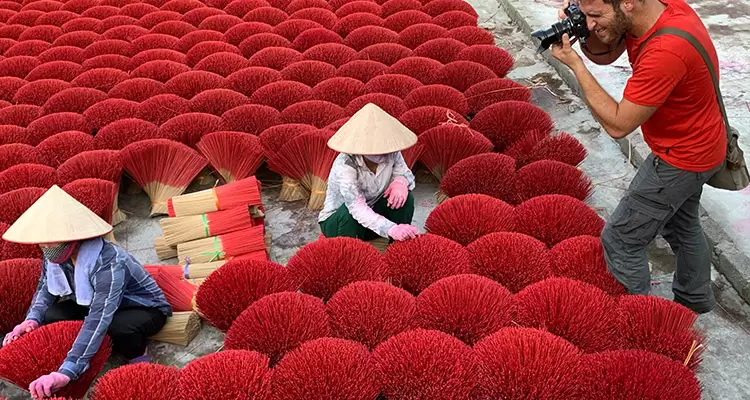
The North becomes cold at this time, especially in the mountains, but visiting Mai Chau is still appealing to many travelers because of its pretty nature and interesting culture. Ban Gioc Waterfall, one of Top 10 Waterfalls in Vietnam, is often at its best beauty in this time of year with good water flow and clear conditions. And visiting the Perfume Pagoda in its off-season can be very relaxing, allowing you to truly appreciate nature. Hanoi is cool and festive.
Meanwhile, the South still offers travelers sunny beaches and warm water in Mui Ne, Phu Quoc, and the Con Dao islands, making it a popular winter sun destination. Central Vietnam sees an end to its rainy season, with places like Hoi An and Hue becoming pleasant for exploration.
There are so many places for tourists to discover in Vietnam. No matter what time you plan to visit, Vietnam Travel organizes private tours to your choice of destinations. Visitors escorted by our professional guides will get the chance to explore the best of Vietnam. Ask travel questions, or get tour help related to the best time to visit Vietnam and adventures, please feel free to contact Vietnam Travel’s tour planners today.
Key Takeaways
To help you visualize the diverse opportunities across Vietnam, here’s a general guide. Remember, weather can be variable, but this provides a good starting point for your travel planning.
| Month | Northern Vietnam (Hanoi, Sapa, Halong Bay, Ha Giang, Mai Chau, Ninh Binh) | Central Vietnam (Hoi An, Da Nang, Hue, Nha Trang, Dalat, Phong Nha) | Southern Vietnam (HCMC, Mekong Delta, Phu Quoc, Con Dao) |
|---|---|---|---|
| Jan | Cool, dry; Sapa/Ha Giang cold (frost possible). Highlights: Trekking, Hanoi exploration, Ha Giang plum blossoms, pre-Tet atmosphere. | Coastal (Hoi An, Da Nang, Hue): End of rains, improving. Nha Trang: Dry, sunny. Dalat: Cool, dry. Highlights: Nha Trang beaches, Dalat exploration, Hue/Hoi An cultural sites. | Dry, hot, sunny. Highlights: HCMC city tours, Mekong River cruises, Phu Quoc/Con Dao beaches. |
| Feb | Cool, mostly dry; spring flowers (peach, plum). Highlights: Sapa/Moc Chau flower viewing, trekking, festivals (Tet often falls here). | Coastal: Dry, warm, sunny. Nha Trang: Excellent. Dalat: Dry. Highlights: Beach time (Da Nang, Hoi An, Nha Trang), Hoi An tailoring, Hue Imperial City. | Dry, hot, sunny. Highlights: Ideal for beaches (Phu Quoc, Con Dao),Mekong Delta exploration, HCMC sightseeing. |
| Mar | Pleasant, warming up, dry; good for trekking. Highlights: Sapa trekking, Halong Bay cruises, Hanoi sightseeing. | Excellent; hot, dry, sunny. Dalat: Pleasant. Highlights: Prime beach weather, Hoi An, Hue exploration, Phong Nha caves. | Hot, dry, sunny; can be very hot late March. Highlights: HCMC, Mekong Delta, island getaways before peak heat. |
| Apr | Warm, mostly dry; good for highlands. Highlights: Sapa, Mai Chau, Ninh Binh (lush landscapes), Halong Bay. | Hot, dry, sunny. Dalat: Pleasant. Highlights: Beaches, diving/snorkeling (Nha Trang, Phu Quoc), Phong Nha caves. | Peak hot and dry season. Highlights: Good for all southern destinations, though prepare for heat. |
| May | Hot, humid, start of rainy season; rains often afternoon showers. Highlights: Lush landscapes, Ninh Binh, Mai Chau, Pu Luong butterfly season. | Hot, dry, sunny. Dalat: Start of wet season. Highlights: Beaches, Da Nang Fireworks. | Warm, start of wet season; short afternoon showers. Highlights: Mekong Delta (fruit season), HCMC, Phu Quoc/Con Dao (expect some rain). |
| Jun | Hot, humid, rainy; lush greenery. Highlights: Mountain retreats (Sapa, Mai Chau), Hanoi museums. | Hot, dry, sunny. Dalat: Wet. Highlights: Da Nang Fireworks (DIFF), beaches, Hoi An. | Warm, wet; afternoon downpours common. Highlights: Lush Mekong Delta, fewer crowds, Phu Quoc/Con Dao (afternoon showers). |
| Jul | Hot, humid, wettest month with August; rare Halong Bay disruptions. Highlights: Deep green landscapes, photography. | Hot, dry, sunny. Dalat: Wet. Highlights: Da Nang Fireworks (DIFF 2025 ends July 12), prime beach time (Nha Trang, Da Nang). | Warm, wet; peak rainfall with August. Highlights: Mekong Delta vibrant, HCMC (plan around showers), Phu Quoc/Con Dao (expect rain). |
| Aug | Hot, humid, very rainy. Highlights: Consider indoor activities in >Hanoi or focus on other regions. | Hot, dry, sunny (Hoi An, Da Nang, Hue start to transition end of month). Nha Trang: Still good. Dalat: Wet. Highlights: Beaches, cultural sites before rain increases. | Warm, wet; peak rainfall. Highlights: Lush scenery, potential for lower prices, plan for afternoon rain. |
| Sep | Warm, decreasing rain, pleasant autumn. Highlights: Harvest season in mountains (Sapa, Mu Cang Chai), Hanoi autumn. | Start of rainy season coastal (Hoi An, Da Nang, Hue); typhoons possible. Nha Trang: End of dry season. Dalat: Wet. Highlights: Nha Trang still pleasant early Sep. | Warm, wet; decreasing rain towards end of month. Highlights: Mekong Delta still green, HCMC, Phu Quoc/Con Dao (improving weather). |
| Oct | Cool, dry, clear skies; excellent for trekking. Highlights: Sapa golden rice terraces, Ha Giang buckwheat flowers, Hanoi. | Peak rainy season coastal (Hoi An, Da Nang, Hue); typhoons possible. Nha Trang: Rainy. Dalat: Wet. Highlights: Focus on North/South. Cultural immersion if in Central. | Warm, decreasing rain; pleasant. Highlights: Good for all southern destinations as dry season approaches. |
| Nov | Cool, dry, comfortable. Highlights: Ideal for Hanoi, Halong Bay, Ninh Binh, trekking. | Rainy season continues coastal, but easing end of month. Nha Trang: Rainy. Dalat: Dry, pleasant. Highlights: Dalat exploration. | Dry season begins; hot, sunny, excellent. Highlights: Prime time for HCMC, Mekong Delta, Phu Quoc, Con Dao. |
| Dec | Cool, dry; Sapa/Ha Giang can be cold. Highlights: Hanoi festive season, trekking, Halong Bay. | Coastal: Drier, cooler; good for Hoi An/Hue exploration. Nha Trang: End of rainy season. Dalat: Cool, dry. Highlights: Hoi An lanterns, Hue history, Dalat. | Dry, hot, sunny; peak tourist season. Highlights: Ideal for all southern destinations, beaches, festive atmosphere. |
Best time to travel to Vietnam by destinations:
-
July and August are ideal for beach lovers.
-
December to March is the season to visit Hanoi and Ho Chi Minh City.
-
April to June and September to November are good to avoid crowds.
-
Spring (February to April) and autumn (August to October) have mild and dry weather.
-
November through April is generally the best time for most of Vietnam.
| Vietnam Destinations | Best Time to Visit |
|---|---|
| Hanoi | Oct–Dec |
| Sapa | Mar–May |
| Halong Bay | Oct–Apr |
| Ninh Binh | Feb–Apr |
| Hoi An & Da Nang | Feb–May |
| Ho Chi Minh City | Dec–Apr |
| Mekong Delta | Dec–Apr |
